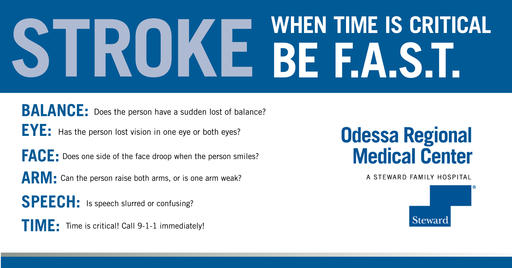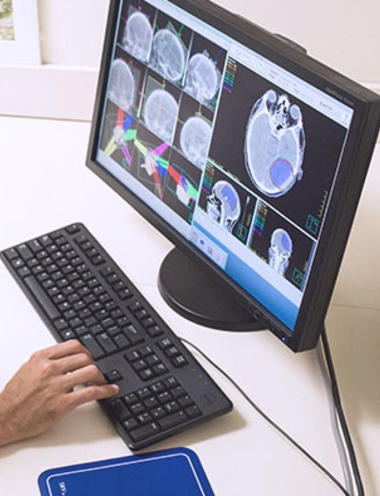
What is a stroke
According to the Center for Disease Control and Prevention (CDC), stroke is the fifth leading cause of death in the United States and is a major cause of serious disability for adults.
Stroke is an injury to the brain that occurs when the brain's blood supply is interrupted. Blood carries oxygen which is necessary for all cells in the body to survive. The brain has one of the highest demands for oxygen. In fact, cells in the brain start to die if they are without oxygen-rich blood for more than a few minutes. The death of these brain cells can result in permanent brain damage. Other terms for stroke include cerebrovascular accident (CVA) or brain attack.
Time is brain! Treatment options are available for stroke, but time is crucial. Call 911 immediately if you or someone nearby is experiencing the warning signs of stroke.
Types and Causes of Stroke
Ischemic Stroke
An ischemic stroke occurs when a blood vessel of the brain becomes blocked. Nearly 90 percent of all strokes are ischemic. Blockage may be caused by:
- Carotid artery stenosis. Narrowing of the carotid arteries that supply blood to the brain. The narrowing occurs as a result of atherosclerosis, the buildup of plaque (fat, cholesterol, and other substances) inside artery walls.
- Thrombus. A blood clot that forms in the arteries of the brain, often a result of atherosclerosis.
- Embolism. A blood clot that travels from another part of the body. In many cases, the clot travels from the heart and gets trapped in the arteries that supply blood to the brain. A common cause of embolism is atrial fibrillation, a type of heart arrhythmia.
- Arterial spasm. Blood vessels have muscular walls that can tighten or loosen to help blood flow. Problems with nerves, blood vessel structure, injuries, or stimulants can cause these muscles to spasm and tighten, making it difficult for blood to flow through the blood vessel. Although spasms can cause problems on their own, they may be more likely to cause blockages in blood vessels with current atherosclerosis.
Hemorrhagic Stroke
A stroke may also occur if a blood vessel breaks and bleeds into or around the brain. Hemorrhagic stroke is the most common type of stroke in young people. The leading causes of this type of stroke are:
- Hypertension. Blood pressure is the force of blood on arteries walls. Prolonged high blood pressure damages and weakens blood vessels.
- Brain aneurysm. An aneurysm is an outpouching of a blood vessel wall in the brain that form in areas where the artery wall is weak or thin. The bulging, blood-filled pocket can put pressure on parts of the brain. Aneurysms that burst often have devastating consequences.
- Ateriovenous malformations (AVM). A rare condition marked by abnormal connections that occur between arteries and veins. Instead of an artery supplying an area of the brain with blood, it is connected directly to a vein that takes it away, bypassing the brain tissue that needs it. The blood vessels may be weakened over time. This, in turn, may cause widening of the vessels, which may eventually burst.
Silent Stroke
A silent stroke occurs without any typical signs or symptoms of a stroke. Despite this, silent strokes cause damage to brain tissue and increase the risk of a major stroke in the future. Silent strokes tend to occur in silent areas of the brain that are not obviously active in cognitive function or mobility. Brain tissue damage is usually found incidentally during imaging tests.
Are you at risk for a stroke?
According to the Centers for Disease Control and Prevention (CDC), stroke is a leading cause of death and serious long-term disability — with someone in the U.S. suffering a stroke every 40 seconds. To determine if you are at risk for stroke, please answer the following questions.
- Do you or an immediate family member ever have a stroke?
- Have you ever had a heart attack or experienced angina?
- Do you have diabetes?
- Have you ever been diagnosed with high blood pressure? (biggest risk factor for stroke)
- Have you ever been diagnosed with high cholesterol?
- Do you smoke?
- Do you exercise regularly (minimum 30 minutes, three times a week)?
- Are you more than 14 lbs. overweight?
- Do you consume alcohol on a daily basis?
- Are you 50 years of age or older?
If you answered “yes” to three or more of the above questions, please contact your personal medical provider. This questionnaire has been created for educational purposes only and should not be used as a substitute for professional medical advice, diagnosis, treatment or care. Only a physician or other qualified health care provider can accurately diagnose and treat stroke.
Signs and Symptoms of Stroke

- Sudden numbness or weakness in the face, arm, or leg, especially on one side of the body
- Sudden confusion, trouble speaking, or difficulty understanding speech
- Sudden trouble seeing in one or both eyes
- Sudden trouble walking, dizziness, loss of balance, or lack of coordination
- Sudden severe headache with no known cause
- Sudden loss of memory
Look for the same signs/symptoms. If you suspect stroke in an adult or child, call 911!



